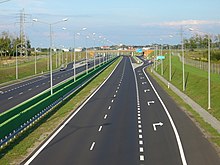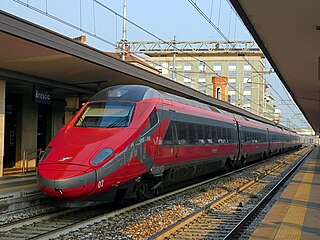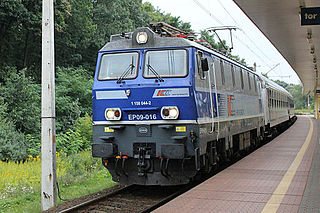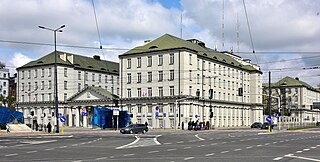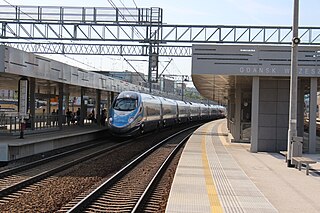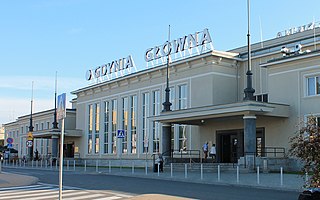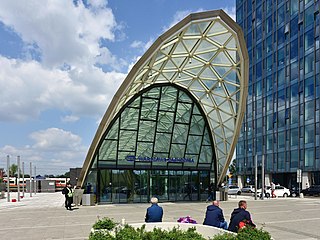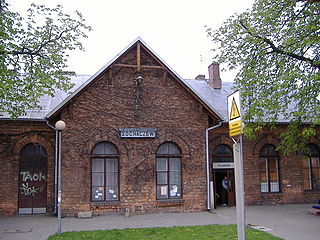Rail transport




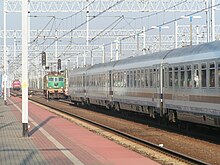
Poland is served by an extensive network of railways. In most cities the main railway station is located near a city centre and is well connected to the local transportation system. The infrastructure is operated by PKP Group. The rail network is very dense in western and northern Poland, while eastern part of the country is less developed. The capital city, Warsaw, has the country's only rapid transit system: the Warsaw Metro.
The only high-speed rail line (though by most definitions, real high-speed rail only includes speeds over 200 km/h) in central-eastern Europe is the Central Rail Line (Poland), Centralna Magistrala Kolejowa (CMK). It has a length of 223 km (139 mi), and was built in 1971–1977; it links Warsaw with Kraków and Katowice. Most trains on the CMK operate at speeds up to 160 km/h (99 mph), but since December 2014 new Alstom Pendolino ED250 trains operate on a 90 km section of the CMK at 200 km/h (124 mph), and improvements under way should raise the authorized speed to 200 km/h (124 mph) on most of the line. In test runs on the CMK in November 2013 a new Pendolino ED250 train set a new Polish speed record of 293 km/h (182 mph). [1]
Other high-speed lines:
- The Warsaw-Gdańsk-Gdynia railway route is undergoing a major upgrading costing $3 billion, partly funded by the European Investment Bank, including track replacement, realignment of curves and relocation of sections of track to allow speeds up to 200 km/h (124 mph), modernization of stations, and installation of the most modern ETCS signalling system, which is to be completed in June 2015. In December 2014 new Alstom Pendolino ED250 high-speed trains were put into service between Gdańsk, Warsaw, Katowice and Kraków reducing the rail travel time from Gdańsk to Warsaw to 2 hours 58 minutes, [2] [3] to be reduced in late 2015 to 2 hours 37 minutes. [4]
- Warsaw–Kutno–Poznań–(Berlin) (160 km/h)
- Warsaw–Siedlce–Terespol–(Minsk) (160, 120 km/h) – being upgraded to 160 km/h
- Warsaw–Puławy–Lublin (120, 140 km/h)
- Opole–Wrocław (160 km/h) and further upgraded via Legnica to Berlin and Hamburg
Projects The Warsaw–Łódź line is being upgraded to allow speed up to 160 km/h (in order to bind together the Warsaw–Łódź agglomeration).
Plans were made to construct a new high-speed line (350 km/h) from Warsaw to Poznań and Wrocław with forks in Łódź and Kalisz., [5] but the project was cancelled in November 2011 due to its high cost. [6]
The PKP Group is the fourth largest railway throughout Europe. Trains are run by its different subsidiaries.
Passenger transport operators
The following companies operate in Poland:
- PKP Intercity – qualified passengers trains (express, intercity, eurocity, hotel and TLK)
- Przewozy Regionalne – regional passengers trains (normal and fast train)
- Koleje Śląskie - regional trains in Silesian Voivodeship
- Koleje Mazowieckie – local trains in Mazovia centered on Warsaw
- Szybka Kolej Miejska (Tricity) – fast urban railway serving the Tricity area of Gdańsk, Gdynia and Sopot
- Szybka Kolej Miejska (Warsaw) – suburban railway in Warsaw agglomeration
- Warszawska Kolej Dojazdowa – suburban railway in Warsaw agglomeration
- Arriva RP (owned by Deutsche Bahn) – part of the local train traffic in Kuyavian-Pomeranian Voivodeship
- Koleje Dolnośląskie – part of the local train traffic in Lower Silesian Voivodeship
- Koleje Wielkopolskie – part of the local train traffic in Greater Poland Voivodeship
- Łódzka Kolej Aglomeracyjna - commuter railway operator in Łódź Voivodeship
Narrow-gauge railways
There are hundreds of kilometres of 600 mm (1 ft 11+5⁄8 in), 750 mm (2 ft 5+1⁄2 in), 785 mm (2 ft 6+29⁄32 in), and 1,000 mm (3 ft 3+3⁄8 in) narrow-gauge lines in Poland. These railways are mostly in decline, some survive as a museum or tourist railways.
Freight transport market
- PKP Cargo
- PKP LHS – Metallurgic broad-gauge line
- PTK Holding SA – The railway transportation holding in Zabrze
- Przedsiębiorstwo Transportu Kolejowego i Gospodarki Kamieniem Rybnik – The Railway Transport and Stone Management Company in Rybnik
- CTL Logistics
- PCC Rail Szczakowa – Rail Szczakowa website – part of the German concern PCC AG
- Kopalnia Piasku Kotlarnia – The Kotlarnia sand mine
- Kopalnia Piasku Kuźnica Warężyńska – The Kuźnica Warężyńska sand mine
- Orlen KolTrans
- Lotos Kolej
- Nadwiślanski Zakład Transportu Kolejowego- Vistula Rail Transport Company]
Broad-gauge railways
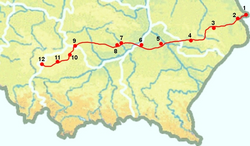
Except for Linia Hutnicza Szerokotorowa, and a few very short stretches near border crossings, Poland uses the standard gauge for its railways. Therefore, Linia Hutnicza Szerokotorowa (known by its acronym LHS, English: Broad-gauge steelworks line) in Sławków is the longest broad-gauge railway line in Poland. The line runs on a single track for almost 400 km (250 mi) from the Polish-Ukrainian border, crossing it just east of Hrubieszów. It is the westernmost broad-gauge railway line in Europe that is connected to the broad-gauge rail system of the countries of the former Soviet Union.
Rail system
Total: 23,420 km (14,550 mi)
- standard gauge 1,435 mm (4 ft 8+1⁄2 in) : 21,639 km (13,450 mi) (11,626 km (7,220 mi) electrified; 8,978 km (5,580 mi) double track)
- broad gauge 1,520 mm (4 ft 11+27⁄32 in) : 646 km (401 mi)
- narrow gauge (various) : 1,135 km (710 mi) various gauges including 1,000 mm (3 ft 3+3⁄8 in), 785 mm (2 ft 6+29⁄32 in), 750 mm (2 ft 5+1⁄2 in), and 600 mm (1 ft 11+5⁄8 in) (1998)
As of December 2002 narrow-gauge railways were no longer owned or operated by PKP. They were transferred to regional authorities or became independent companies.
Rail links with adjacent countries
- Same gauge:
- Break-of-gauge – 1,435 mm (4 ft 8+1⁄2 in)/1,520 mm (4 ft 11+27⁄32 in)

